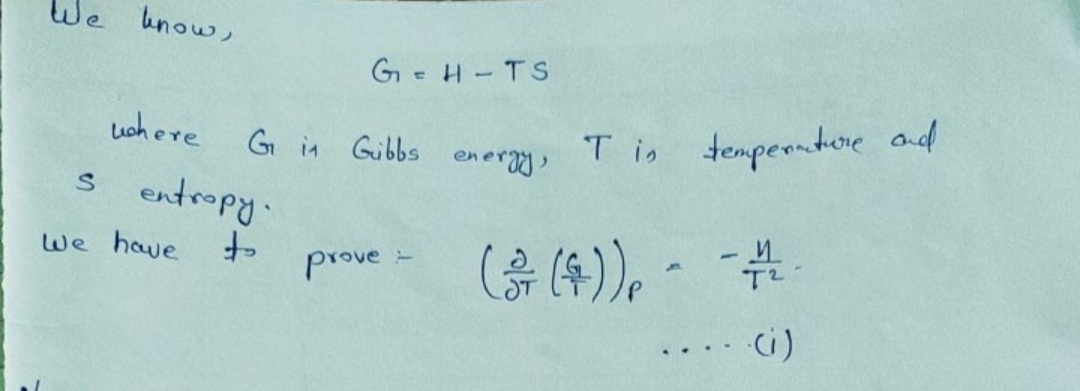Chemistry
10th Edition
ISBN:9781305957404
Author:Steven S. Zumdahl, Susan A. Zumdahl, Donald J. DeCoste
Publisher:Steven S. Zumdahl, Susan A. Zumdahl, Donald J. DeCoste
Chapter1: Chemical Foundations
Section: Chapter Questions
Problem 1RQ: Define and explain the differences between the following terms. a. law and theory b. theory and...
Related questions
Question
![**Problem Statement:**
Prove that
\[
\left( \frac{\partial}{\partial T} \left( \frac{G}{T} \right) \right)_P = -\frac{H}{T^2}.
\]
**Explanation:**
This expression is a thermodynamic relation involving partial derivatives. It is commonly used in the context of Gibbs free energy (\(G\)), temperature (\(T\)), and enthalpy (\(H\)).
**Details:**
- The left-hand side of the equation, \(\left( \frac{\partial}{\partial T} \left( \frac{G}{T} \right) \right)_P\), represents the partial derivative of \( \frac{G}{T} \) with respect to temperature \(T\), while holding pressure \(P\) constant.
- The right-hand side, \(-\frac{H}{T^2}\), indicates that this derivative is equal to the negative of the enthalpy divided by the square of the temperature.
This relation is essential for understanding the temperature dependence of Gibbs free energy in various thermodynamic processes.](/v2/_next/image?url=https%3A%2F%2Fcontent.bartleby.com%2Fqna-images%2Fquestion%2F37df213a-2c14-4822-a979-37f159717cfc%2Ff9ecc240-4f98-4e81-b395-f8d82f00c169%2Feh502xe_processed.png&w=3840&q=75)
Transcribed Image Text:**Problem Statement:**
Prove that
\[
\left( \frac{\partial}{\partial T} \left( \frac{G}{T} \right) \right)_P = -\frac{H}{T^2}.
\]
**Explanation:**
This expression is a thermodynamic relation involving partial derivatives. It is commonly used in the context of Gibbs free energy (\(G\)), temperature (\(T\)), and enthalpy (\(H\)).
**Details:**
- The left-hand side of the equation, \(\left( \frac{\partial}{\partial T} \left( \frac{G}{T} \right) \right)_P\), represents the partial derivative of \( \frac{G}{T} \) with respect to temperature \(T\), while holding pressure \(P\) constant.
- The right-hand side, \(-\frac{H}{T^2}\), indicates that this derivative is equal to the negative of the enthalpy divided by the square of the temperature.
This relation is essential for understanding the temperature dependence of Gibbs free energy in various thermodynamic processes.
Expert Solution
Step 1

Step by step
Solved in 2 steps with 2 images

Knowledge Booster
Learn more about
Need a deep-dive on the concept behind this application? Look no further. Learn more about this topic, chemistry and related others by exploring similar questions and additional content below.Recommended textbooks for you

Chemistry
Chemistry
ISBN:
9781305957404
Author:
Steven S. Zumdahl, Susan A. Zumdahl, Donald J. DeCoste
Publisher:
Cengage Learning

Chemistry
Chemistry
ISBN:
9781259911156
Author:
Raymond Chang Dr., Jason Overby Professor
Publisher:
McGraw-Hill Education

Principles of Instrumental Analysis
Chemistry
ISBN:
9781305577213
Author:
Douglas A. Skoog, F. James Holler, Stanley R. Crouch
Publisher:
Cengage Learning

Chemistry
Chemistry
ISBN:
9781305957404
Author:
Steven S. Zumdahl, Susan A. Zumdahl, Donald J. DeCoste
Publisher:
Cengage Learning

Chemistry
Chemistry
ISBN:
9781259911156
Author:
Raymond Chang Dr., Jason Overby Professor
Publisher:
McGraw-Hill Education

Principles of Instrumental Analysis
Chemistry
ISBN:
9781305577213
Author:
Douglas A. Skoog, F. James Holler, Stanley R. Crouch
Publisher:
Cengage Learning

Organic Chemistry
Chemistry
ISBN:
9780078021558
Author:
Janice Gorzynski Smith Dr.
Publisher:
McGraw-Hill Education

Chemistry: Principles and Reactions
Chemistry
ISBN:
9781305079373
Author:
William L. Masterton, Cecile N. Hurley
Publisher:
Cengage Learning

Elementary Principles of Chemical Processes, Bind…
Chemistry
ISBN:
9781118431221
Author:
Richard M. Felder, Ronald W. Rousseau, Lisa G. Bullard
Publisher:
WILEY